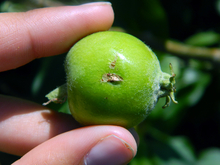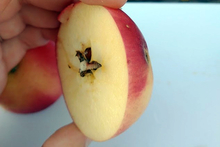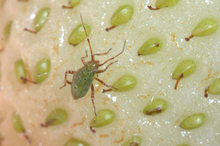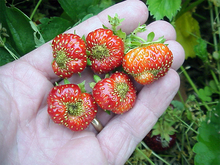It’s easy to get overwhelmed by all the insect pests and diseases that show up on fruit crops. The good news is that many of them are harmless or just occasional pests. Let’s focus on the most important ones that can have the biggest impact on your fruit crop’s success.
Here are three key insect pests to look for in June.
Plum curculio
Look for this insect pest on apple trees and stone fruit trees like tart cherries, plums, and apricots.
The plum curculio weevil infests fruit trees shortly after the end of bloom (called “petal fall”). The females attempt to lay eggs in the fruitlets, leaving crescent-shaped scars on the skin. Sometimes, the scar just looks like a small black dot. As the fruitlets grow, they remain misshapen around the scar.
If an egg develops into larvae, the larvae feed on the inside of the fruit, causing internal damage and some of the fruit to drop. The damaged fruit are still edible—just cut out damaged parts before eating.
Managing plum curculio
- Shake branches to remove the adult weevils: Once you notice the adult plum curculio weevils, place a white sheet under the tree. Shake the branches to make the insects fall onto the sheet. Roll it up and dunk it in a bag or bucket of soapy water to kill the weevils. This works best early in the morning, when the insects are inactive and more likely to fall than to fly away.
- Spray a physical barrier: Kaolin clay, which can be purchased at local garden centers, creates a hard physical barrier on the fruit, preventing insects from piercing them. The tricky part is that the fruit must be completely covered for it to work, and it runs off during each heavy rainfall.
- Bag the fruit: Tie small plastic or mesh bags around each fruit to prevent insects from reaching them. This is time consuming, but if all you want is 100 apples, then just bag 100 apples and leave the others to nature. If your bags have no holes, poke a couple in the bottom to release condensation.
- Spray an insecticide after bloom: If you choose this option, please wear personal protective gear like a mask, glasses, pants, and gloves. Do not spray directly over your head - if this is impossible to avoid, then consider other options or hire a tree care professional. Follow all directions on the label. Look for products containing acetamiprid, carbaryl, gamma-cyhalothrin, permethrin, pyrethrins, or spinosad.
Codling moth
Look for this pest on apples.
Codling moths lay eggs on developing apples in June. Larvae hatch and tunnel through the fruit, often ending up in the core. Look for brown or black residue on the calyx (bottom) of the apple. This is often where they enter. Infested fruit are edible, but watch out for the larvae and their tunnels of frass.
Garden-scale management options for codling moth
- Use traps: Purchase codling moth pheromone traps online. Traps contain a pheromone lure to attract the moths, and a sticky surface to keep them there. Apple orchards usually use traps for monitoring, to see when codling moths have arrived in order to schedule insecticide sprays. However, several traps together in one garden may be powerful enough to also control them. Place traps in late May. Know what the flies look like, as the traps will catch various insects. They work for 1-2 months.
- Bag the fruit: Tie small plastic or mesh bags around each fruit to prevent insects from reaching them. This is time consuming, but if all you want is 100 apples, then just bag 100 apples and leave the others to nature. If your bags have no holes, poke a couple in the bottom to release condensation.
- Spray an insecticide once codling moths are detected: If infestations are severe year after year and other methods have not worked, you may consider insecticides. Only spray an insecticide once you know that you have codling moths in your garden (set a trap to monitor, see above). Spraying an insecticide without knowledge of the insect’s presence could needlessly kill beneficial insects while missing the pest. Once you start noticing codling moths in your trap, spray an effective insecticide containing spinosyn, carbaryl, esfenvalerate or malathion.
- See more information on codling moth.
Tarnished plant bug
Look for this insect pest on strawberries.
Tarnished plant bugs are small green nymphs that suck liquid from strawberry blossoms and developing berries, causing the berries to be small and misshapen. They also feed on other fruit plants and some vegetables but are the biggest problem on strawberries because of the damage caused to the berries. Watch for them whenever strawberries are in bloom.
If you observe “catface” damage to the fruit, the damage happened earlier, during bloom.
Garden-scale management options for tarnished plant bug
- Weed the patch: Since TPB also lives among numerous weeds and common garden plants, weeding the strawberry patch may help keep them away.
- Try using exclusion netting: Insect exclusion netting placed over the plants might reduce TPB feeding IF it is applied before bloom, and if there is not already a population present in the patch when the netting is applied. It is worth a try, but may or may not work.
- Know when they’re there: To tell if TPB is present, place a white sheet of paper under the plants. Shake the leaves to drop the insects onto the paper. This is not a strong control measure, and is only meant to see if they are there. Spray if at least 4 out of 30 flower clusters have the nymphs.
- Spray if needed: Only start insecticide control measures once you know the insect is present. Look for products containing carbaryl, acetamiprid, or pyrethroids
- While Pyganic can be used, there is little to no research supporting its effectiveness on TPB. It would also need to be applied frequently as it only kills the insects by directly touching them.
- Find more information on tarnished plant bug from the University of Wisconsin.
CAUTION: Protect pollinators! If an insecticide spray during bloom is necessary, protect bees by only spraying insecticides in the early morning or late evening when bees are less active.
CAUTION: Mention of a pesticide or use of a pesticide label is for educational purposes only. Always follow the pesticide label directions attached to the pesticide container you are using. Be sure that the plant you wish to treat is listed on the label of the pesticide you intend to use. And observe the number of days between pesticide application and when you can harvest your crop. Remember, the label is the law.





